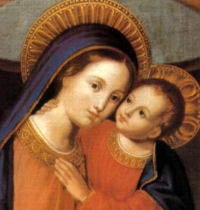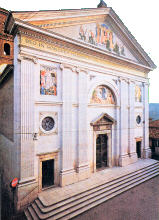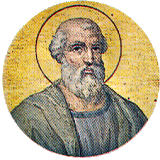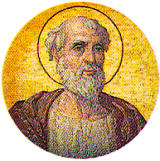
Daily Readings for: April 26, 2013
(Readings on USCCB website)
Collect: O God, author of our freedom and of our salvation, listen to the voice of our pleading and grant that those you have redeemed by the shedding of your Son's Blood may have life through you and, under your protection, rejoice for ever unharmed. Through our Lord Jesus Christ, your Son, who lives and reigns with you in the unity of the Holy Spirit, one God, for ever and ever.
- ’Tis Said of Our Dear Lady
- A Single Branch Three Roses Bore
- Ave Maria Dear
- Beautiful, Glorious
- Celebrating the Feasts of the Blessed Virgin
- Mary Garden
- Religion in the Home for Elementary School: April
- Salve Regina
- Stella Matutina
- Virgin Blessed, Thou Star the Fairest
- Regina Coeli (Queen of Heaven)
- Prayers for the Easter Season
- Table Blessing for the Feasts of the Mother of God
- Novena to St. Catherine of Siena
RECIPES
ACTIVITIES
PRAYERS
LIBRARY
Easter: April 26th
Friday of the Fourth Week of Easter; Optional Memorial of Our Lady of Good Counsel (Can)
Old Calendar: Saints Cletus and Marcellinus, popes and martyrs; Our Lady of Good Counsel
The devotion to our Lady of Good Counsel originated at Gennazzano, a village in the neighborhood of Rome, where an Augustinian church, in which is enshrined a miraculous picture of our Lady, had been for centuries a place of popular pilgrimage. This feast is observed in Canada.
According to the 1962 Missal of Bl. John XXIII the Extraordinary Form of the Roman Rite, today is the feast of Sts. Cletus and Marcellinus. St. Cletus, who is probably identical with St. Anacletus (his feast moved from July 13 before 1961), figures in the list of Popes as the second successor of St. Peter, A.D. 76-88. St. Marcellinus governed the Church two centuries later, from A.D. 296 to 304, during the terrible Diocletian persecution.
Our Lady of Good Counsel On the Feast of Saint Mark, April 25 1467, the people of Genazzano, Italy witnessed a marvellous sight. A cloud descended upon an ancient church dedicated to Our Lady of Good Counsel. When the cloud disappeared, an image of Our Lady and the Child Jesus was revealed which had not been there before. The image, on a paper-thin sheet, was suspended miraculously.
On the Feast of Saint Mark, April 25 1467, the people of Genazzano, Italy witnessed a marvellous sight. A cloud descended upon an ancient church dedicated to Our Lady of Good Counsel. When the cloud disappeared, an image of Our Lady and the Child Jesus was revealed which had not been there before. The image, on a paper-thin sheet, was suspended miraculously.
Soon after the image's appearance many miracles were attributed to the intercession of Our Lady of Good Counsel. Because of this, Pope Paul II ordered an investigation and the results have been preserved.
It was later discovered that the very same image had been seen in a church dedicated to the Annunciation in Scutari, Albania. The image in this church was said to have arrived there in a miraculous manner. Now, the image had been transported from Albania miraculously to avoid sacrilege from Moslem invasion.
A commission of enquiry determined that a portrait from the church was indeed missing. An empty space the same size as the portrait was displayed for all to see.
Many miracles continue to be attributed to Our Lady of Good Counsel. Pope Saint Pius V, for example, credited victory in the Battle of Lepanto to Her intercession.
Several Popes have approved the miraculous image. In 1682 Pope Innocent XI had the portrait crowned with gold. On July 2 1753 Pope Benedict XIV approved the Scapular of Our Lady of Good Counsel, and was the first to wear it.
In 1884 a special Mass and Office of the Feast of Our Lady of Good Counsel was approved by Pope Leo XIII.
For more than 500 years the image has continued to attract countless pilgrims.
Although much of the church was destroyed during World War II, the image has remained intact — and continues to be suspended miraculously.
Patron: Albania, enlightenment.
St. Cletus I Emperor Vespasian reigned in Rome when Cletus assumed leadership of the Church. His specific responsibilities, like those of his predecessor Linus, can only be surmised because a monarchial episcopate had not yet emerged in Rome. Little is known of Cletus, perhaps due to the confusion over his name. Some historians refer to him as Anacletus or, more correctly, Anencletus, which is a Greek adjective meaning "blameless." There is, however, no doubt that he is recognized as the third successor and is commemorated in the ancient canon of the Mass.
Emperor Vespasian reigned in Rome when Cletus assumed leadership of the Church. His specific responsibilities, like those of his predecessor Linus, can only be surmised because a monarchial episcopate had not yet emerged in Rome. Little is known of Cletus, perhaps due to the confusion over his name. Some historians refer to him as Anacletus or, more correctly, Anencletus, which is a Greek adjective meaning "blameless." There is, however, no doubt that he is recognized as the third successor and is commemorated in the ancient canon of the Mass.
According to tradition, he appointed twenty-five presbyters for Rome and erected a shrine over the burial place of Peter. He is said to have died a martyr, in the twelfth year of the reign of Emperor Domitian, and was buried on the Vatican Hill.
Excerpted from The Popes: A Papal History, J.V. Bartlett
St. Marcellinus St. Marcellinus was Pope during the Diocletian persecution (296-304). With wise forethought he ordered large rooms to be constructed in the catacombs for liturgical use. Such a chamber in the catacomb of Callistus still recalls his action. According to one ancient account (certainly erroneous), this pope strewed incense before the gods when arrested during the persecution, but later atoned for his weakness by a glorious martyrdom. His grave in the catacomb of Priscilla was an object of highest honor.
St. Marcellinus was Pope during the Diocletian persecution (296-304). With wise forethought he ordered large rooms to be constructed in the catacombs for liturgical use. Such a chamber in the catacomb of Callistus still recalls his action. According to one ancient account (certainly erroneous), this pope strewed incense before the gods when arrested during the persecution, but later atoned for his weakness by a glorious martyrdom. His grave in the catacomb of Priscilla was an object of highest honor.
Excerpted from The Church's Year of Grace, Pius Parsch